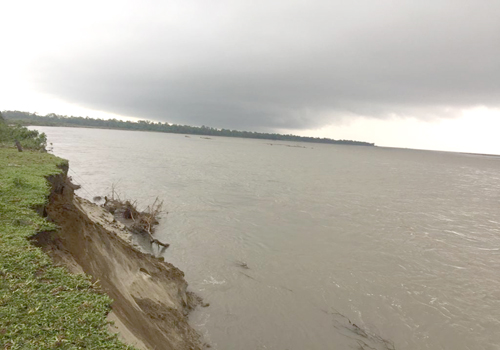[ Tongam Rina ]
SERAM, Sep 30: The Siang River has submerged a large portion of land in Seram village, East Siang during the current monsoon season, forcing relocation of many families to safer parts of the village.
The river is expanding laterally towards its left, in the direction of the village, and has submerged vast areas of the village and forested land in two months.
Several granaries and two homes are underwater, while 13 families were forced to dismantle their homes. Many villagers who lived near the river have shifted to other parts of the village, abandoning their homes as the Siang continues to swallow portions of the village.
 Acres of forest land in Borguli Bakkul, just adjacent to Seram, have been submerged, too.
Acres of forest land in Borguli Bakkul, just adjacent to Seram, have been submerged, too.
“There was a temporary chopper landing ground and a festival ground, but all have been swallowed by the Siang,” said N Pertin, who was fishing in the river, near the submerged forest land.
A village of 157 registered houses, Seram has more than 500 people. The villagers are worried that the Siang will eventually swallow Seram altogether.
A major portion of the village area was submerged in the 2000 Siang floods, forcing the people to shift to the higher grounds, but there is no respite still, as the river continues to expand each monsoon.
Many say that they would have to look for other alternatives, as it is no longer safe to stay in the village with the flow of the Siang becoming more unpredictable.
Tokmin Lego, who originally is from neighbouring Mibang in Lower Dibang Valley district, said he would move back to his village.
“I shifted to Seram looking for better livelihood options, but one can’t live in constant fear. Who knows what the Siang will decide,” he said.
Toramai Pegu, a farmer, has abandoned farming. She said she was unable to deal with the uncertainty of the river. Instead of sharecropping, she has now opened a small shop next to the concrete village road, which has now almost become the boundary between the river and the village.
Many who had paddy fields near the river have lost their land.
Eighty-year-old Keppi Libang dismantled her home after her neighbour’s home was damaged by the river.
“If I had not, the Siang would have,” she said. She lost her granary and the toilet to the river.
“It took us four days to build the new home. We had to divide the village workforce as there were many houses being built at around the same time,” she says.
“The Siang keeps expanding. Inch by inch the river is eroding the village. We have been living in fear for years now,” says the great grandmother.
With the river’s level mounting, the school was shifted a year back. This year the community hall has also been shifted.
“How long shall we keep shifting towards the mountain?” asked T Pertin, who volunteers to keep the village clean.
The villagers say there has been very little help from the government, and there has been no flood protection measure on the Siang, which has led to land erosion.
“When a home is lost, we get some money, but there has to be a permanent solution,” said a villager.
In the recently-constructed village community hall, redolent with the smell of fresh paint, a group of volunteers, mostly young men, keeping guard of the river, were on a break as they observed a ritual to mark the end of the Solung festival.
“Every year, the Siang keeps spreading. Every year we make sandbags, but that is temporary. All it takes is a second to destroy months of hard work,” they said.
While the villagers live in fear of rain and the floods it brings, many in the village have abandoned their paddy cultivation because there was not enough rain during the paddy transplantation period.
Pirik Modi said she abandoned half of her paddy field because there was not enough rain.
“For the last few years, the rain keeps coming at the wrong time of the paddy season,” she said. “We have had droughts and floods in the same cultivation season. The weather has become as unpredictable as the Siang.”
There was barely any rain in entire June-July but it started raining heavily, though sporadically, in August and September, she said.
The government has announced compensation of Rs 1 lakh each for the families who have lost their homes, and Rs 37,500 for every hectare of washed-away agricultural land.
Bidol Tayeng, secretary of the disaster management department, said once the assessment of lost agricultural land is completed, compensation would be given to each one of those who have lost their land.
Even as the villagers continue to live in uncertainty and fear, MP Ninong Ering has demanded dredging of the Siang riverbed by the end of 2018.
He termed the Central Water Commission’s (CWC) report on the condition of the Siang river “dissatisfying and distracting.”
“The condition of Siang river is in a sorrow state, and yet the CWC data paints a rosy picture to keep real suffering and plight of people in oblivion,” Ering stated in a letter to Union Home Minister Rajnath Singh recently.
While Seram is the worst affected, Namsing, Mer, Gadum, Gadum-II, and Kongkul in Mebo Subdivision are also facing the threat from the Siang.



